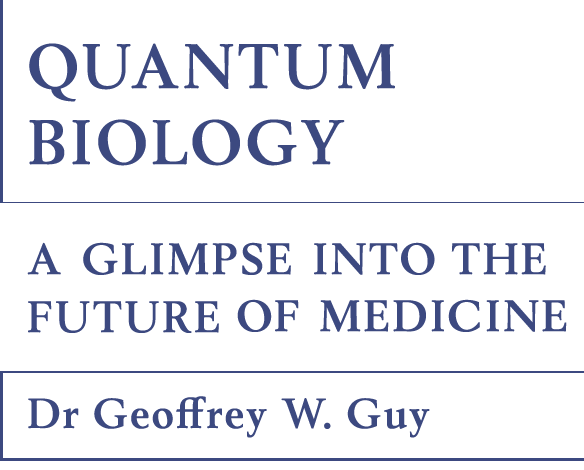
- About Geoffrey Guy
- List of chapters
- 1 Flatworms and xenobots
- 2 Beyond neurons: quantum effects in the brain
- 3 The ghost in the machine
- 4 Inflammation and equilibrium
- 5 The light fantastic
- 6 Lessons from the pandemic
- 7 Reassessing the causes of cancer
- 8 Energy, information and light
- 9 Before the origins of life
- 10 Unravelling the double helix
- 11 The computer in our cells
- 12 Space: the quantum frontier?
- 13 The quantum fractal
- 14 The path to mainstream
- Glossary
- Buy the book



8
Energy, information and light
This page provides online resources relating to Chapter 8 of Quantum Biology: A Glimpse into the Future of Medicine. Read a chapter extract, or scroll down to access figures and terminology, additional resources published by The Guy Foundation, and a list of further reading.
Name of the Chapter
Subheading
In the old days, if you wanted to know whether you were being fired at by a cannon, you’d look for the flash. You didn’t listen for the sound because the sound would arrive at the same time as the cannonball, and it was too late by then. We think the little flash of a biophoton may well be part of a signalling system. Even if it is a by-product, that by-product is still being utilised. It would be very unusual to conclude that something which has survived billions of years of evolution isn’t being utilised in some way.
We think a biophoton can take both energy and information with it. When it impacts on a target atom, it will alter the excitation state of that target. An electron will jump from its original location to an orbit with higher energy that is further away from the nucleus of the atom. That’s part of the reason why holding a copper rod in a flame turns the flame from yellow to green. But that biophoton is also carrying information.
Buy the book here
Quantum entanglement is the phenomenon whereby two subatomic particles remain linked to each other even if they are separated. A change induced in one will immediately affect the other.
The term synchrony is used in different branches of science, from mathematics to oceanography, to describe the way in which two or more things happen at the same time or speed. It may be a pattern such as tidal rhythm, animal mating behaviour or a group of musicians playing together. It can also refer to the precise moment in time an event takes place, such as two photons arriving together at the same point.
2022 Autumn Series Proceedings
Quantum mitochondria: energy, information and implications for health and disease
December 2022
2019 Autumn Colloquium Proceedings
What biophotonics can tell us about the bioquantome
June 2020
Read the proceedings here.
Videos

The Guy Foundation 2024 Autumn Series
Electrical circuits in biology – quantum or classical?
Professor Gregory Scholes, Princeton University

The Guy Foundation 2021 Spring Series
At the interface of quantum and classical behavior in nature: looking into the eye of quantum tunneling in enzymes and the role of a noisy environment
Professor Judith Klinman, UC Berkeley

The Guy Foundation 2020 Spring Series
Quantum Dynamics and Biology
Professor Martin Plenio, Ulm University
Also visit The Guy Foundation YouTube Channel Mitochondria Playlist
See the Playlist.
A. P. Bat’yanov, ‘Distant-optical interaction of mitochondria through quartz’, Bulletin of Experimental Biology and Medicine 97 (1984), doi.org/10.1007/BF00804160
V. V. Chaban, T. Cho, C. B. Reid and K. C. Norris, ‘Physically disconnected non-diffusible cell-to-cell communication between neuroblastoma SH-SY5Y and DRG primary sensory neurons’, American Journal of Translational Research 5:1 (2013), pmc.ncbi.nlm.nih.gov/articles/PMC3560476/
Ashkan Farhadi, Christopher Forsyth, Ali Banan et al., ‘Evidence for non-chemical, non-electrical intercellular signaling in intestinal epithelial cells’, Bioelectrochemistry 71:2 (2007), doi.org/10.1016/j.bioelechem.2007.03.001
Lucas Freitas de Freitas and Michael R. Hamblin, ‘Proposed mechanisms of photobiomodulation or low-level light therapy’, IEEE Journal of Selected Topics in Quantum Electronics 22:3 (2016), doi.org/10.1109/JSTQE.2016.2561201
M. Gori, P. Kurian and A. Tkatchenko, ‘Second quantization of many-body dispersion interactions for chemical and biological systems’, Nature Communications 14 (2023), doi.org/10.1038/s41467-023-43785-z
S. N. Mayburov, ‘Photonic communications and information encoding in biological systems’, arXiv q-bio (2011), doi.org/10.48550/arXiv.1205.4134
Rhys R. Mould, Elizabeth L. Thomas, Geoffrey W. Guy, Alistair V. W. Nunn and Jimmy D. Bell, ‘Cell-cell death communication by signals passing through non-aqueous environments: a reply’, Results in Chemistry 4 (2022), doi.org/10.1016/j.rechem.2022.100538
Ian Nodurft, Thomas Searles, Brian Kirby and Ryan Glasser, ‘Forced entanglement of circularly polarized photons’, NASA/ADS (2022), ui.adsabs.harvard.edu/abs/2022APS..MARS35002N/abstract
Chad Orzel, How to Teach Quantum Physics to Your Dog (London: Oneworld, 2010)
X. Shen, W. Mei and X. Xu, ‘Activation of neutrophils by a chemically separated but optically coupled neutrophil population undergoing respiratory burst’, Experientia 50 (1994), doi.org/10.1007/BF01923488
Yan Sun, Chao Wang and Jiapei Dai, ‘Biophotons as neural communication signals demonstrated by in situ biophoton autography’, Photochemical & Photobiological Sciences 9 (2010), doi.org/10.1039/b9pp00125e
